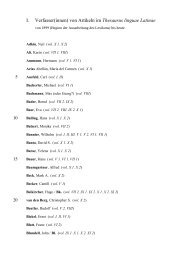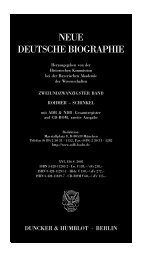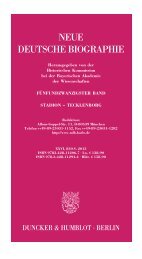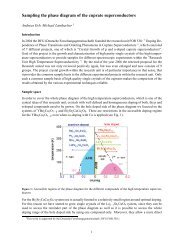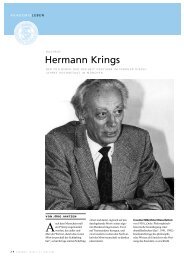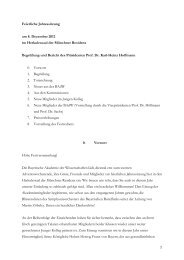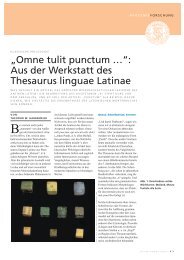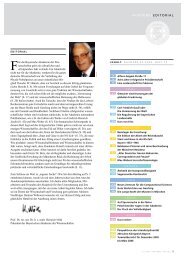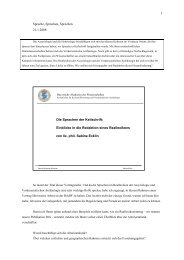II. Applications of the Josephson Effect
II. Applications of the Josephson Effect
II. Applications of the Josephson Effect
Create successful ePaper yourself
Turn your PDF publications into a flip-book with our unique Google optimized e-Paper software.
Chapter 4<br />
<strong>Applications</strong><br />
<strong>of</strong> <strong>the</strong><br />
<strong>Josephson</strong> <strong>Effect</strong>
R. Gross, A. Marx, and F. Deppe © Wal<strong>the</strong>r-Meißner-Institut (2001 - 2013)<br />
<strong>II</strong>. <strong>Applications</strong> <strong>of</strong> <strong>the</strong> <strong>Josephson</strong> <strong>Effect</strong><br />
AS-Chap. 4 - 2<br />
large number <strong>of</strong> analog and digital applications:<br />
• I s m = I s m B :<br />
magnetic field sensors (SQUIDs) (ch. 4)<br />
• β C ≫ 1:<br />
bistability: zero/voltage state<br />
switching devices, <strong>Josephson</strong> computer (ch. 5)<br />
• 2 nd <strong>Josephson</strong> equation dφ/dt = 2eV/ħ<br />
VCO, voltage standard (ch. 6)<br />
• nonlinear IVC<br />
mixers up to THz, oscillators (ch. 7)<br />
• macroscopic quantum behavior<br />
superconducting qubits (ch. 9)
R. Gross, A. Marx, and F. Deppe © Wal<strong>the</strong>r-Meißner-Institut (2001 - 2013)<br />
4. Superconducting Quantum Interference Devices<br />
Superconducting Quantum Interference Devices = SQUID<br />
single <strong>Josephson</strong> junction as can be used as<br />
magnetic field sensor: I s m = I s m B<br />
- sensitivity: dI s /dΦ ≈ I s m /Φ 0 = I s m /B 0 t B L<br />
increase t B L to increase sensitivity<br />
• superconducting loop with one or more <strong>Josephson</strong> junctions<br />
relevant area: loop area<br />
• dual or multi-beam interference:<br />
Superconducting Quantum Interference Devices (SQUIDs)<br />
• relevant physics:<br />
flux quantization in superconducting loops and <strong>Josephson</strong> effect<br />
• SQUIDs = most sensitive detectors for magnetic flux<br />
• can detect every quantity that can be converted into magnetic flux:<br />
magnetic field, field gradient, current, voltage, displacement, …<br />
• most relevant types <strong>of</strong> SQUIDs:<br />
direct current (dc) and radio frequency (rf) SQUIDs<br />
• dc-SQUIDs: highest energy sensitivity at low temperatures<br />
AS-Chap. 4 - 3
R. Gross, A. Marx, and F. Deppe © Wal<strong>the</strong>r-Meißner-Institut (2001 - 2013)<br />
Die Kalmare (Teuthida) stellen mit rund 300 Arten die größte Gruppe innerhalb der Kopffüßer<br />
dar. Gemeinsam mit den Echten Tintenfischen (Sepiida), den Zwergtintenfischen (Sepiolida) und<br />
dem Posthörnchen (Spirula spirula), das allein eine eigene Gruppe Spirulida darstellt, bilden sie<br />
die Gruppe der Zehnarmigen Tintenfische (Decapoda).<br />
AS-Chap. 4 - 4
R. Gross, A. Marx, and F. Deppe © Wal<strong>the</strong>r-Meißner-Institut (2001 - 2013)<br />
AS-Chap. 4 - 5<br />
4.1 The dc-SQUID<br />
4.1.1 The Zero Voltage State<br />
2 JJs (lumped elements) connected in parallel, identical I c
R. Gross, A. Marx, and F. Deppe © Wal<strong>the</strong>r-Meißner-Institut (2001 - 2013)<br />
4.1.1 The Zero Voltage State<br />
AS-Chap. 4 - 6<br />
total phase change along closed contour = 2¼n:<br />
use:
R. Gross, A. Marx, and F. Deppe © Wal<strong>the</strong>r-Meißner-Institut (2001 - 2013)<br />
4.1.1 The Zero Voltage State<br />
AS-Chap. 4 - 7<br />
• substitution:<br />
• integration <strong>of</strong> A:<br />
closed loop total flux Φ 0 threading <strong>the</strong> loop<br />
• integration for J s :<br />
J s vanishes deep inside electrode material ∫ ΛJ s ⋅ dl vanishes<br />
• result: phase differences are not independent but linked via <strong>the</strong> fluxoid quantization:<br />
• if Φ = Φ ext : maximum possible supercurrent is obtained for sin(…) = 1 as<br />
problem solved!
R. Gross, A. Marx, and F. Deppe © Wal<strong>the</strong>r-Meißner-Institut (2001 - 2013)<br />
4.1.1 The Zero Voltage State<br />
AS-Chap. 4 - 8<br />
• problem: finite inductance L <strong>of</strong> <strong>the</strong> loop <br />
• for a symmetrical loop we can write:<br />
average supercurrent<br />
circulating current<br />
equations have to be solved<br />
self-consistently<br />
maximum I s m : maximize I s with<br />
respect to φ 1 with constraint
R. Gross, A. Marx, and F. Deppe © Wal<strong>the</strong>r-Meißner-Institut (2001 - 2013)<br />
4.1.1 The Zero Voltage State<br />
AS-Chap. 4 - 9<br />
• relevance <strong>of</strong> finite inductance is characterized by<br />
screening parameter:<br />
• negligible screening: β L ≪ 1<br />
flux due to circulating current can be neglected<br />
maximum supercurrent for given Φ ext :<br />
from dI s /dφ 1 = 0 <br />
A = 2 mm 2 ,<br />
B ext = 1 nT<br />
Φ ext =<br />
Φ 0
R. Gross, A. Marx, and F. Deppe © Wal<strong>the</strong>r-Meißner-Institut (2001 - 2013)<br />
4.1.1 The Zero Voltage State<br />
AS-Chap. 4 - 10<br />
• large screening: β L ≫ 1<br />
LI c ≫ Φ 0 circulating current compensates external field<br />
total flux in <strong>the</strong> loop tends to be quantized:<br />
transport current:<br />
circulating current:<br />
constraint:<br />
for given I and Φ: 2 equations for φ 1,2 ⇒ Φ cir = LI cir and Φ ext<br />
e.g.: for I ≃ 0: sin φ 1 ≃ − sin φ 2 and:<br />
in summary we get: Φ Φ ext<br />
• how does Φ Φ ext look like in detail ?
R. Gross, A. Marx, and F. Deppe © Wal<strong>the</strong>r-Meißner-Institut (2001 - 2013)<br />
4.1.1 The Zero Voltage State<br />
• finite screening:<br />
β L > 0<br />
• small β L : single valued/non-hysteretic Φ Φ ext<br />
• maximum value <strong>of</strong> Φ cir ≃ LI c<br />
• single valued Φ Φ ext curve for: |Φ cir | ≤ Φ 0<br />
⇒ LI 2 c ≤ Φ 0<br />
2<br />
(more precisely: β L ≤ 2/π)<br />
⇒<br />
β L ≤ 1<br />
AS-Chap. 4 - 11
R. Gross, A. Marx, and F. Deppe © Wal<strong>the</strong>r-Meißner-Institut (2001 - 2013)<br />
4.1.1 The Zero Voltage State<br />
AS-Chap. 4 - 12<br />
• how does I m s Φ ext look like?<br />
- qualitative discussion for large β L<br />
I cir → 0 for large I → I s m ≃ 2I c<br />
start with n = 0:<br />
small screening current I cir ≃ −Φ ext /L screens field<br />
I 1 decreases, I 2 increases with increasing Φ ext I 2 ≤ I c<br />
modulation depth <strong>of</strong> I s m Φ ext is strongly reduced with increasing β L (∝ 1/β L )
R. Gross, A. Marx, and F. Deppe © Wal<strong>the</strong>r-Meißner-Institut (2001 - 2013)<br />
4.1.2 The Voltage State<br />
• negligible screening: ¯L ¿ 1, strong damping: ¯C ¿ 1<br />
total flux = applied flux<br />
displacement current can be neglected:<br />
total current = <strong>Josephson</strong> + resistive current<br />
• identical junctions:<br />
• define new phase:<br />
with F ' F ext = const <br />
IVC ´ IVC <strong>of</strong> single junction with flux dependent I c<br />
mechanical analogue: two pendula, for ¯L ¿ 1 rigid coupling <strong>of</strong> <strong>the</strong> pendula<br />
AS-Chap. 4 - 13
R. Gross, A. Marx, and F. Deppe © Wal<strong>the</strong>r-Meißner-Institut (2001 - 2013)<br />
4.1.2 The Voltage State<br />
AS-Chap. 4 - 14<br />
• single junction IVC for ¯C ¿ 1:<br />
periodic IVCs, period: © 0<br />
V(© ext ): periodic<br />
minima and maxima at same positions<br />
maximum modulation for I ' 2I c
R. Gross, A. Marx, and F. Deppe © Wal<strong>the</strong>r-Meißner-Institut (2001 - 2013)<br />
4.1.2 The Voltage State<br />
AS-Chap. 4 - 15<br />
• finite screening: ¯L » 1, intermediate damping: ¯C » 1<br />
- increase flux threading loop: larger loops large L<br />
- consider displacement + noise current<br />
numerical solution required !<br />
• basic equations:<br />
relates voltage to phase change<br />
fluxoid quantization<br />
coupling
R. Gross, A. Marx, and F. Deppe © Wal<strong>the</strong>r-Meißner-Institut (2001 - 2013)<br />
4.1.2 The Voltage State<br />
AS-Chap. 4 - 16<br />
• mechanical analogue: 2 pendula with mass M and length l coupled via twistable bar<br />
- for negligible screening (¯L ¿ 1): rigid bar<br />
relative angle 1 - 2 = 2¼© ext /© 0 fixed by external flux<br />
single combined pendulum with mass 2M, distance from pivot point: l cos(( 1 - 2 )/2)<br />
without torque: pendula reside at ( 1 - 2 )/2<br />
with torque (bias current): combined pendula rotate<br />
I = 0 I > 0
R. Gross, A. Marx, and F. Deppe © Wal<strong>the</strong>r-Meißner-Institut (2001 - 2013)<br />
4.1.3 Operation and Performance <strong>of</strong> dc-SQUIDs<br />
¯C < 1 non-hysteretic IVCs<br />
I > 2I c<br />
AS-Chap. 4 - 17
R. Gross, A. Marx, and F. Deppe © Wal<strong>the</strong>r-Meißner-Institut (2001 - 2013)<br />
4.1.3 Operation and Performance <strong>of</strong> dc-SQUIDs<br />
¯C < 1 non-hysteretic IVCs<br />
I > 2I c<br />
AS-Chap. 4 - 18
R. Gross, A. Marx, and F. Deppe © Wal<strong>the</strong>r-Meißner-Institut (2001 - 2013)<br />
4.1.3 Operation and Performance <strong>of</strong> dc-SQUIDs<br />
AS-Chap. 4 - 19<br />
• important parameters for practical applications <strong>of</strong> SQUIDs<br />
flux-to-voltage transfer coefficient (measure <strong>of</strong> sensitivity to flux):<br />
maximum at steepest point <strong>of</strong> hVi(F ext )<br />
flux to voltage transducer<br />
equivalent flux noise (measure <strong>of</strong> flux resolution)<br />
S V (f): power spectral density <strong>of</strong> voltage<br />
noise at fixed bias current<br />
noise energy (measure <strong>of</strong> energy resolution, good for comparison <strong>of</strong> different SQUID geometries)<br />
sets energy resolution<br />
should be as small as possible
R. Gross, A. Marx, and F. Deppe © Wal<strong>the</strong>r-Meißner-Institut (2001 - 2013)<br />
4.1.3 Operation and Performance <strong>of</strong> dc-SQUIDs<br />
for given S V (f): maximize H and L:<br />
1. bias current: I ¸ I c : largest modulation <strong>of</strong> hVi(F ext )<br />
2. flux bias: close to (2n+1) F 0 /4<br />
3. junction critical current: coupling energy E J À k B T<br />
simulations show: I c ¸ 5¢I th ´ 5¢2¼k B T/F 0<br />
@ 4.2 K: I c ¸ 1 ¹A<br />
4. loop inductance: should be large<br />
but: <strong>the</strong>rmal noise flux (k B TL) 1/2 ¿ F 0<br />
define <strong>the</strong>rmal inductance: L th I th = F 0 /2<br />
simulations: L · 0.2¢L th<br />
@ 4.2 K: L · 1 nH<br />
define:<br />
5. screening parameter: ¯L = 2I c L/© 0 < 1 no hysteresis in hVi(F ext )<br />
small L, but large area choose ¯L » 1<br />
small I c ≈ 1 ¹A @ 4.2 K L · 1 nH<br />
6. Stewart-McCumber parameter: ¯c < 1 no hysteresis in IVC (external shunt)<br />
choose ¯c ' 1 for large voltage output<br />
AS-Chap. 4 - 20
R. Gross, A. Marx, and F. Deppe © Wal<strong>the</strong>r-Meißner-Institut (2001 - 2013)<br />
4.1.3 Operation and Performance <strong>of</strong> dc-SQUIDs<br />
AS-Chap. 4 - 21<br />
• detailed numerical simulations:<br />
²(f) minimum for ¯L » 1, ¯c ' 1 at (2n+1)F 0 /4, at max. voltage modulation (≈I c R N )<br />
<strong>the</strong>n:<br />
• small signal analysis in white noise regime (@ optimal point):<br />
T, C<br />
J c , ! p
R. Gross, A. Marx, and F. Deppe © Wal<strong>the</strong>r-Meißner-Institut (2001 - 2013)<br />
4.1.3 Operation and Performance <strong>of</strong> dc-SQUIDs<br />
• improve performance od dc-SQUID: decrease T and C, increase J c<br />
- ²(f) is given in units <strong>of</strong> ~ ' 10 -34 Js<br />
• optimized SQUIDs: ²(f) approaches quantum limit, practical SQUIDs: ²(f) ≈ 10 ~<br />
• dimensionless parameter:<br />
• reduced noise energy:<br />
rapid increase for<br />
°¯L > 0.2<br />
<strong>the</strong>rmal noise rounding<br />
<strong>of</strong> IVC<br />
D. Kölle et al., Rev. Mod. Phys. 71, 631 (1999)<br />
AS-Chap. 4 - 22
R. Gross, A. Marx, and F. Deppe © Wal<strong>the</strong>r-Meißner-Institut (2001 - 2013)<br />
4.1.4 Practical dc-SQUIDs<br />
AS-Chap. 4 - 23<br />
we need:<br />
- antenna,<br />
- SQUID,<br />
- room temperature electronics
R. Gross, A. Marx, and F. Deppe © Wal<strong>the</strong>r-Meißner-Institut (2001 - 2013)<br />
4.1.4 Practical dc-SQUIDs<br />
AS-Chap. 4 - 24<br />
• today:<br />
fabrication:<br />
SQUIDs and antenna consist <strong>of</strong> thin film structures<br />
by optical and electron beam lithography<br />
• washer type SQUID:<br />
- large sensitivity large area<br />
- but large L deterioration <strong>of</strong> performance<br />
large effective area &<br />
small inductance:<br />
perfect diamagnetism<br />
washer type<br />
easy coupling to<br />
antenna:<br />
planar spiral coil
R. Gross, A. Marx, and F. Deppe © Wal<strong>the</strong>r-Meißner-Institut (2001 - 2013)<br />
4.1.4 Practical dc-SQUIDs<br />
AS-Chap. 4 - 25<br />
• loop currents around inner opening defines L = 1.25 ¹ 0 D (for W À D)<br />
effective area: A eff / D¢W<br />
• limit: flux trapping in washer area flux noise by <strong>the</strong>rmally activated motion<br />
• flux focusing effect in washer-type YBCO grain boundary junction dc SQUID<br />
M.B. Ketchen et al.,<br />
Appl. Phys. Lett. 40, 736 (1982)<br />
R. Gross et al.,<br />
Appl. Phys. Lett. 57, 727 (1990)
R. Gross, A. Marx, and F. Deppe © Wal<strong>the</strong>r-Meißner-Institut (2001 - 2013)<br />
4.1.4 Practical dc-SQUIDs<br />
spiral input coil:<br />
coil inductance:<br />
mutual inductance:<br />
coupling coefficient:<br />
L S : stripline inductance<br />
n: # <strong>of</strong> turns<br />
n 2 L: coil geometric self inductance<br />
example: D = 20 ¹m L ' 30 pH<br />
n = 50 L i ' 75 nH and M i ' 1.5 nH (® ex ' 0.6 – 0.8)<br />
AS-Chap. 4 - 26
R. Gross, A. Marx, and F. Deppe © Wal<strong>the</strong>r-Meißner-Institut (2001 - 2013)<br />
4.1.4 Practical dc-SQUIDs<br />
low-T c dc-SQUIDs:<br />
- multilayer thin film technology<br />
- high plasma frequency (high J c )<br />
- small junctions<br />
( small capacitance)<br />
- Nb/AlO x /Nb technology<br />
specific problem: capacitance between spiral input coil and square washer<br />
LC resonances excess noise<br />
AS-Chap. 4 - 27
R. Gross, A. Marx, and F. Deppe © Wal<strong>the</strong>r-Meißner-Institut (2001 - 2013)<br />
AS-Chap. 4 - 28<br />
4.1.4 Practical dc-SQUIDs<br />
high-T c dc-SQUIDs:<br />
- heteroepitaxial growth <strong>of</strong> <strong>the</strong> different SC layers<br />
- low reproducibility <strong>of</strong> junctions<br />
- alternatives: flip-chip design, directly coupled SQUID (only 1 SC layer required)
R. Gross, A. Marx, and F. Deppe © Wal<strong>the</strong>r-Meißner-Institut (2001 - 2013)<br />
AS-Chap. 4 - 29<br />
4.1.5 Read-Out Schemes<br />
• flux-locked loop operation<br />
- hVi(F ext ) curve is nonlinear<br />
- linearization by feedback circuit<br />
linear input – output relation<br />
- oscillating flux, amplitude F 0 /2<br />
- f mod ≈ 100 kHz – several MHz<br />
• quasistatic flux = nF 0 : rectified input<br />
2f mod component<br />
lock-in detection at f mod zero<br />
• quasistatic flux = (n+1/4) F 0 :<br />
maximum lock-in output signal<br />
• detection <strong>of</strong> ac voltage:<br />
cooled transformer:<br />
SQUID impedance matching:<br />
R d N 2 R d<br />
low-noise preamplifier
R. Gross, A. Marx, and F. Deppe © Wal<strong>the</strong>r-Meißner-Institut (2001 - 2013)<br />
4.1.5 Read-Out Schemes<br />
flux-locked loop:<br />
L f :<br />
feedback coil<br />
small flux change ±F to SQUID positive output / ±F<br />
increase <strong>of</strong> integrator output voltage<br />
increase <strong>of</strong> current through feedback coil<br />
compensates ±F<br />
SQUID voltage (and integrator output) stay constant null detector<br />
±V in / ±F ±I f = ±V in /R f ±F f = k 2 L f ±I f<br />
<strong>the</strong>n from |±F f | = |±F |:<br />
f mod » 100 kHz – several MHz: bandwidth up to 100 kHz, dynamic range ¸ 140 dB<br />
“slew rate”: up to 10 7 © 0 /s<br />
AS-Chap. 4 - 30
R. Gross, A. Marx, and F. Deppe © Wal<strong>the</strong>r-Meißner-Institut (2001 - 2013)<br />
AS-Chap. 4 - 31<br />
4.1.5 Read-Out Schemes<br />
• bias current reversal:<br />
- bias current is modulated (to suppress low-frequency noise <strong>of</strong> <strong>Josephson</strong> junctions)<br />
- asymmetric part <strong>of</strong> critical current fluctuations can be eliminated<br />
double modulation technique<br />
• additional positive feedback:<br />
- asymmetric hVi(F ext ) (part <strong>of</strong> <strong>the</strong> bias current is used)<br />
- steeper slope larger V/F<br />
direct read-out with RT electronics<br />
• digital read-out schemes:<br />
- cryogenic digital feedback schemes compact, wide bandwidth<br />
digitized output signals for transmission to RT<br />
• relaxation oscillation schemes:<br />
- hysteretic junctions<br />
- SQUID shunted by series LR<br />
- frequency <strong>of</strong> relaxation oscillations depends on flux<br />
large SQUID output voltage
R. Gross, A. Marx, and F. Deppe © Wal<strong>the</strong>r-Meißner-Institut (2001 - 2013)<br />
4.2 The rf-SQUID<br />
AS-Chap. 4 - 32<br />
requires only 1 <strong>Josephson</strong> junction:<br />
- rf current is applied via tank circuit inductively coupled to SQUID loop<br />
- measure time-averaged tank circuit voltage<br />
advantage: only 1 JJ, no dc-current to SQUID<br />
disadvantage: energy resolution (limited by read-out electronics)<br />
4.2.1 The zero voltage state<br />
total phase change:<br />
using:<br />
and:
R. Gross, A. Marx, and F. Deppe © Wal<strong>the</strong>r-Meißner-Institut (2001 - 2013)<br />
4.2.1 The zero voltage state<br />
substitution:<br />
integration <strong>of</strong> A total flux<br />
large thickness: 2 nd integral can<br />
be omitted<br />
supercurrent:<br />
total flux:<br />
screening parameter:<br />
¯L,rf >1:<br />
unstable regions<br />
negative slope<br />
practically relevant<br />
at © ext = © ext,c :<br />
junction critical current reached<br />
flux quantum enters SQUID ring<br />
hysteresis loop<br />
AS-Chap. 4 - 33
R. Gross, A. Marx, and F. Deppe © Wal<strong>the</strong>r-Meißner-Institut (2001 - 2013)<br />
4.2.2 Operation and Performance <strong>of</strong> rf SQUIDs<br />
AS-Chap. 4 - 34<br />
operation <strong>of</strong> rf-SQUIDs:<br />
- SQUID loop inductively coupled to LC tank circuit<br />
- quality factor Q = R T /! rf L T<br />
! rf2 = 1/L T C T<br />
- mutual inductance M = ®(L T L) 0.5<br />
- rf current in tank circuit: I T = QI rf<br />
for ¯L,rf < 1:<br />
©(© ext ) non-hysteretic<br />
rf-SQUID as nonlinear inductor<br />
periodic modulation <strong>of</strong> resonance frequency (L T,eff C T ) -1/2<br />
operation close to resonance frequency: strong change in rf-voltage
R. Gross, A. Marx, and F. Deppe © Wal<strong>the</strong>r-Meißner-Institut (2001 - 2013)<br />
4.2.2 Operation and Performance <strong>of</strong> rf SQUIDs<br />
AS-Chap. 4 - 35<br />
for ¯L,rf > 1:<br />
©(© ext ) hysteretic<br />
total flux through SQUID:<br />
for © S + © rf > © ext,c hysteresis loop<br />
energy loss / area<br />
damping <strong>of</strong> tank circuit:<br />
minimum close to n¢© 0<br />
maximum close to (2n+1)/2¢© 0<br />
tank voltage is periodic in applied flux
R. Gross, A. Marx, and F. Deppe © Wal<strong>the</strong>r-Meißner-Institut (2001 - 2013)<br />
dependence <strong>of</strong> V T on © S and © rf :<br />
start at © S = n¢© 0 , n = 0:<br />
V T increases linearly with I rf as long as © rf = MQI rf < © ext,c<br />
critical rf-current: I rf,c = © ext,c /M<br />
tank voltage:<br />
for I rf > I rf,c : jump to k = +1 or k = -1 branch<br />
hysteresis loop, energy loss, decrease <strong>of</strong> rf-current<br />
no hysteresis loops until tank circuit has recovered<br />
fur<strong>the</strong>r increase <strong>of</strong> I rf (A B)<br />
transitions at higher rate<br />
at I rf,r : 1 transition in each rf cycle<br />
start at © S = (n+1/2)¢© 0 , n = 0:<br />
transition to k = +1 branch at: © ext,c - © 0 /2<br />
transition to k = -1 branch at:- (© ext,c +© 0 )/2<br />
first horizontal branch at:<br />
V T (I rf ) curves for intermediate values:<br />
between © S = © 0 /2 and © S = 0<br />
AS-Chap. 4 - 36
R. Gross, A. Marx, and F. Deppe © Wal<strong>the</strong>r-Meißner-Institut (2001 - 2013)<br />
4.2.2 Operation and Performance <strong>of</strong> rf SQUIDs<br />
AS-Chap. 4 - 37<br />
dependence <strong>of</strong> V T on © S and © rf :<br />
- start at © S = n¢© 0 , n = 0:<br />
- V T increases linearly with I rf as long as © rf = MQI rf < © ext,c<br />
- critical rf-current: I rf,c = © ext,c /M<br />
- tank voltage:<br />
for I rf > I rf,c : jump to k = +1 or k = -1 branch<br />
hysteresis loop, energy loss, decrease <strong>of</strong> rf-current<br />
no hysteresis loops until tank circuit has recovered<br />
fur<strong>the</strong>r increase <strong>of</strong> I rf (A B)<br />
transitions at higher rate<br />
at I rf,r : 1 transition in each rf cycle<br />
start at © S = (n+1/2)¢© 0 , n = 0:<br />
transition to k = +1 branch at: © ext,c - © 0 /2<br />
transition to k = -1 branch at:- (© ext,c +© 0 )/2<br />
first horizontal branch at:
R. Gross, A. Marx, and F. Deppe © Wal<strong>the</strong>r-Meißner-Institut (2001 - 2013)<br />
4.2.2 Operation and Performance <strong>of</strong> rf SQUIDs<br />
change <strong>of</strong> V T from © S = 0 to © 0 /2: ! rf L T © 0 /2M<br />
flux-to-voltage transfer function near © S = © 0 /4:<br />
lower bound for M / ®: <strong>the</strong>re must be I rf that intersects <strong>the</strong> first step <strong>of</strong> V T (I rf )<br />
point F has to be to <strong>the</strong> right <strong>of</strong> E<br />
operation: stay on step for all © S , flux locked loop with flux modulation<br />
AS-Chap. 4 - 38
R. Gross, A. Marx, and F. Deppe © Wal<strong>the</strong>r-Meißner-Institut (2001 - 2013)<br />
4.2.2 Operation and Performance <strong>of</strong> rf SQUIDs<br />
AS-Chap. 4 - 39<br />
additional topic: noise in rf-SQUIDs:<br />
- switching k = 0 k = 1: stochastic fluctuations (<strong>the</strong>rmal activation)<br />
noise in step voltage V T flux noise:<br />
noise causes finite slope <strong>of</strong> horizontal branches<br />
extrinsic noise source: preamplifier, lines T amp<br />
eff<br />
energy resolution:<br />
high frequencies (few GHz), cold amplifiers: ² ≈ 3£10 -32 J/Hz<br />
comparison:<br />
rf-SQUID: ² ≈ k B T/! rf<br />
dc-SQUID: ² ≈ k B T/! c (! c = 2¼IcR N /© 0 ≈ 100 GHz)<br />
better energy resolution <strong>of</strong> dc-SQUID because: ! c À ! rf
R. Gross, A. Marx, and F. Deppe © Wal<strong>the</strong>r-Meißner-Institut (2001 - 2013)<br />
4.2.3 Practical rf-SQUIDs<br />
AS-Chap. 4 - 40<br />
low T c rf SQUIDs:<br />
- early versions: toroidal configuration machined from Nb<br />
- operated at 10 MHz, ² ≈ 5£ 10 -29 J/Hz<br />
- now: thin film technology, ² ≈ 10 -32 J/Hz<br />
high T c rf-SQUIDs:<br />
- operating at 77 K<br />
- washer-type rf-SQUIDs incorporated in ¸/2 microstrip resonator
R. Gross, A. Marx, and F. Deppe © Wal<strong>the</strong>r-Meißner-Institut (2001 - 2013)<br />
4.3 additional topic: O<strong>the</strong>r SQUID Configurations<br />
4.3.1 The DROS (Double Relaxation Oscillation SQUID)<br />
AS-Chap. 4 - 41<br />
large flux-to-voltage transfer coefficient, large modulation voltage<br />
direct read-out by RT amplifier<br />
hysteretic dc-SQUID (¯C > 1), hysteretic junction in series + L-R shunt<br />
DROS as comparator <strong>of</strong> <strong>the</strong> two critical currents<br />
voltage output behaves like square wave<br />
flux-to-voltage coefficients up to 3 mV/© 0
R. Gross, A. Marx, and F. Deppe © Wal<strong>the</strong>r-Meißner-Institut (2001 - 2013)<br />
4.3.2 The SQIF<br />
AS-Chap. 4 - 42<br />
for ¯L ¿ 1: dc-SQUID double slit configuration<br />
steeper I sm (© ext ) for optical grid analogue: N junctions in parallel<br />
experimental problem: uniformity <strong>of</strong> junctions and loops<br />
irregular parallel array <strong>of</strong> JJ: Superconducting Quantum Interference Filters<br />
I sm (© ext ) shows sharp peak at zero flux
R. Gross, A. Marx, and F. Deppe © Wal<strong>the</strong>r-Meißner-Institut (2001 - 2013)<br />
4.3.3 Cartwheel SQUID<br />
AS-Chap. 4 - 43<br />
SQUID loop: several loops in parallel reducing total SQUID inductance
R. Gross, A. Marx, and F. Deppe © Wal<strong>the</strong>r-Meißner-Institut (2001 - 2013)<br />
Summary: dc Squid<br />
AS-Chap. 4 - 44<br />
flux-to-voltage transfer coefficient<br />
equivalent flux noise<br />
noise energy
R. Gross, A. Marx, and F. Deppe © Wal<strong>the</strong>r-Meißner-Institut (2001 - 2013)<br />
4.4 Instruments Based on SQUIDs<br />
• SQUIDs sense any signal that can be converted to flux<br />
• SQUID based instrument: antenna determines quantity to be measured:<br />
• input circuit influences signal and noise properties <strong>of</strong> SQUID<br />
• reduction <strong>of</strong> SQUID inductance<br />
® 2 : coupling coefficient<br />
mutual inductance:<br />
AS-Chap. 4 - 46
R. Gross, A. Marx, and F. Deppe © Wal<strong>the</strong>r-Meißner-Institut (2001 - 2013)<br />
4.4.1 Magnetometers<br />
AS-Chap. 4 - 51
R. Gross, A. Marx, and F. Deppe © Wal<strong>the</strong>r-Meißner-Institut (2001 - 2013)<br />
4.4.1 Magnetometers<br />
AS-Chap. 4 - 52
R. Gross, A. Marx, and F. Deppe © Wal<strong>the</strong>r-Meißner-Institut (2001 - 2013)<br />
4.4.2 Gradiometers<br />
AS-Chap. 4 - 53<br />
for biomagnetic measurements:<br />
reduce perturbing environmental magnetic fields<br />
- non-magnetic materials<br />
- ¹-metal shields<br />
- magnetically shielded rooms<br />
and/or: n th -order gradiometers suppression <strong>of</strong> remote signals<br />
PTB Berlin:<br />
7 ¹-metal shields<br />
1 Al layer<br />
active field reduction<br />
shielding factor:<br />
2£ 10 6 @ 0.01 Hz<br />
2£ 10 8 @ 5 Hz
R. Gross, A. Marx, and F. Deppe © Wal<strong>the</strong>r-Meißner-Institut (2001 - 2013)<br />
4.4.2 Gradiometers<br />
AS-Chap. 4 - 54<br />
axial gradiometer<br />
planar gradiometer<br />
1 st order 2 nd order 1 st order, dB z /dx 1 st order, dB z /dy
R. Gross, A. Marx, and F. Deppe © Wal<strong>the</strong>r-Meißner-Institut (2001 - 2013)<br />
4.4.3 Susceptometers<br />
measurement <strong>of</strong> magnetic properties <strong>of</strong> materials<br />
- 1 st or 2 nd order gradiometer & sample in static B field<br />
- sample in one <strong>of</strong> <strong>the</strong> pick-up loops<br />
non-magnetic sample<br />
sample with susceptibilty Â<br />
no output signal<br />
additional flux detected by SQUID<br />
commercial systems: 2 nd order gradiometer, sample axially moving<br />
 with resolution <strong>of</strong> 10 -8 emu @ 1.8 – 400 K up to 7 T<br />
AS-Chap. 4 - 55
R. Gross, A. Marx, and F. Deppe © Wal<strong>the</strong>r-Meißner-Institut (2001 - 2013)<br />
4.4.4 Voltmeters<br />
AS-Chap. 4 - 57<br />
voltage transformed into current via input resistor<br />
- feedback <strong>of</strong> SQUID output to input resistor<br />
flux locked loop (null-balancing <strong>of</strong> voltage)<br />
resolution:<br />
≈ 10 -12 V/(Hz) 1/2 for R i = 0.01 <br />
≈ 10 -10 V/(Hz) 1/2 for R i = 100 <br />
superior for low impedance samples<br />
applications:<br />
transport, noise, <strong>the</strong>rmoelectric properties <strong>of</strong> metallic/superconducting samples
R. Gross, A. Marx, and F. Deppe © Wal<strong>the</strong>r-Meißner-Institut (2001 - 2013)<br />
4.4.5 Radi<strong>of</strong>requency Amplifiers<br />
AS-Chap. 4 - 58<br />
tuned amplifier:<br />
- input circuit: R i , C i , and L i<br />
- for frequencies up to 100 MHz<br />
- noise temperature close to <strong>the</strong> quantum limit T N ≈ hn / k B
R. Gross, A. Marx, and F. Deppe © Wal<strong>the</strong>r-Meißner-Institut (2001 - 2013)<br />
4.5 <strong>Applications</strong> <strong>of</strong> SQUIDs<br />
4.5.1 Biomagnetism<br />
AS-Chap. 4 - 60<br />
biomagnetic method:<br />
- non-invasive detection <strong>of</strong> magnetic signals from human body<br />
biomagnetic imaging:<br />
- field map <strong>of</strong> heart / brain activity source location<br />
(only simple volume conductor models are needed)<br />
MEG: magnetoencephalography<br />
MCG: magnetocardiography<br />
extremely small fields:<br />
brain: 100 fT (one neuron: 0.1 fT), heart: 10 pT<br />
highly sensitive SQUID magnetometers<br />
low 1/f noise<br />
spatial and temporal magnetic<br />
field distribution:<br />
array <strong>of</strong> SQUID sensors (multichannel systems)<br />
(or scan single SQUID)
R. Gross, A. Marx, and F. Deppe © Wal<strong>the</strong>r-Meißner-Institut (2001 - 2013)<br />
4.5.1 Biomagnetism<br />
AS-Chap. 4 - 61<br />
signal reconstruction<br />
- current distribution cannot be calculated from<br />
measured field distribution<br />
inverse problem has no unique solution<br />
model assumptions<br />
based on elementary current dipoles<br />
(= short localized conductor segments &<br />
volume backflow)
R. Gross, A. Marx, and F. Deppe © Wal<strong>the</strong>r-Meißner-Institut (2001 - 2013)<br />
AS-Chap. 4 - 62<br />
4.5.1 Biomagnetism<br />
Magnetocardiography (MCG):<br />
heart signals ≈ 100 pT, fine structure (≈ pT) clinically relevant<br />
source <strong>of</strong> pathological signals with high precision in 3 dimensions<br />
• planar sensor loops B z component<br />
positive and negative components<br />
instantaneous field maps<br />
eg.: false color maps<br />
• each patient: own fingerprint<br />
• use noise suppression techniques<br />
MFMS: magnetic field map sequences<br />
healthy<br />
heart<br />
ventricular<br />
tachycardia
R. Gross, A. Marx, and F. Deppe © Wal<strong>the</strong>r-Meißner-Institut (2001 - 2013)<br />
4.5.1 Biomagnetism<br />
AS-Chap. 4 - 63<br />
11 SQUIDs:<br />
vector components B x , B y , B z on two planes:<br />
B x ~ (B x1 + B x2 )/2<br />
gradient:<br />
B x /x ~ (B x1 - B x2 )<br />
magnetic field during R-peak above thorax <strong>of</strong> healthy heart:
R. Gross, A. Marx, and F. Deppe © Wal<strong>the</strong>r-Meißner-Institut (2001 - 2013)<br />
4.5.1 Biomagnetism<br />
AS-Chap. 4 - 64<br />
Magnetoencephalography (MEG)<br />
functional brain mapping (in contrast to CT/MRI)<br />
intercellular neuronal currents<br />
spatial resolution 2 mm, temporal resolution: 1 ms<br />
optimum SQUID resolution, noise suppression<br />
completely non-invasive, undistorted biosignals<br />
epilepsy, localizing eloquent cortex
R. Gross, A. Marx, and F. Deppe © Wal<strong>the</strong>r-Meißner-Institut (2001 - 2013)<br />
4.5.2 Nondestructive Evaluation (NDE)<br />
non-invasive identification <strong>of</strong> structural or material defects<br />
(sub-) surface cracks in aircrafts<br />
reinforcing rods in concrete strutures<br />
short distance between inner<br />
cold and out warm wall<br />
(spatial resolution)<br />
HTS SQUIDs (@ 77 K)<br />
advantageous<br />
eddy-current techniques:<br />
- alternating field<br />
- eddy currents disturbed by material defects<br />
AS-Chap. 4 - 65
R. Gross, A. Marx, and F. Deppe © Wal<strong>the</strong>r-Meißner-Institut (2001 - 2013)<br />
4.5.2 Nondestructive Evaluation (NDE)<br />
AS-Chap. 4 - 66
R. Gross, A. Marx, and F. Deppe © Wal<strong>the</strong>r-Meißner-Institut (2001 - 2013)<br />
4.5.3 SQUID Microscopy<br />
AS-Chap. 4 - 67<br />
image magnetic field distribution, high sensitivity, modest spatial resolution<br />
- initially: low-T c dc SQUIDs, now: high-T c SQUIDs @ 77 K<br />
- frequency: dc up to 1 GHz<br />
spatial resolution:<br />
- cold samples: 5 ¹m (with s<strong>of</strong>t magnetic focusing tip: 0.1 ¹m)<br />
- RT-samples: 30 – 50 ¹m<br />
applications.<br />
- diagnostics <strong>of</strong> SC devices<br />
- properties <strong>of</strong> ultra-thin magnetic films<br />
- analysis <strong>of</strong> semiconducting devices<br />
SQUID – sample separation:<br />
75 ¹m Sapphire window: 150 ¹m<br />
3 ¹m Si x N y window: 15 ¹m
R. Gross, A. Marx, and F. Deppe © Wal<strong>the</strong>r-Meißner-Institut (2001 - 2013)<br />
4.5.3 SQUID Microscopy<br />
AS-Chap. 4 - 68<br />
alignment track <strong>of</strong> 5.25”<br />
floppy disk<br />
magnetic ink in 1 $ note<br />
flux quanta trapped in<br />
SQUID washer
R. Gross, A. Marx, and F. Deppe © Wal<strong>the</strong>r-Meißner-Institut (2001 - 2013)<br />
4.5.4 Gravity Wave Antennas and Gravity Gradiometers<br />
topics: inertial navigation, general relativity, deviations from 1/r 2 , and gravitational waves:<br />
e.g. collapsing stars, rotating double stars<br />
expansion and contraction oscillations<br />
expected length change ¢l/l ~ 10 -19<br />
required resolution ~ 10 21<br />
resonant mass transducer<br />
displacement current<br />
antenna mK regime<br />
resolution: zero point motion<br />
quantum limited antenna<br />
typical resonance frequency: 1 kHz T< ~! ant /k B ≈ 50 nK<br />
but: increase <strong>of</strong> Q increase <strong>of</strong> effective noise temperature T eff<br />
assume: gravitational pulse, length ¿, antenna decay time Q/! ant :<br />
quantum limit (bar energy > k B T eff ) T < Q~/k B ¿<br />
for Q = 2£10 6 and ¿ = 1 ms T ≈ 20 mK<br />
quantum limited sensor is required<br />
presently: sensitivities ¢l/l ≈ 10 -18 , no gravity waves reported yet<br />
AS-Chap. 4 - 69
R. Gross, A. Marx, and F. Deppe © Wal<strong>the</strong>r-Meißner-Institut (2001 - 2013)<br />
AS-Chap. 4 - 70<br />
4.5.4 Gravity Wave Antennas and Gravity Gradiometers<br />
gravity gradiometer:<br />
gravity gradient separation <strong>of</strong> test masses coil induction<br />
mapping earth’s gravity gradient, test <strong>of</strong> 1/r 2 law<br />
4.5.5 Geophysics<br />
SQUIDs used to probe <strong>the</strong> magnetic properties <strong>of</strong> earth<br />
• rock magnetometry<br />
• mapping earth magnetic field / em impedance<br />
• geophysical surveying
R. Gross, A. Marx, and F. Deppe © Wal<strong>the</strong>r-Meißner-Institut (2001 - 2013)<br />
Summary<br />
negligible screening ¯L = 2LI c /© 0<br />
¿ 1 © » © ext<br />
strong damping:<br />
large screening ¯L = 2LI c /© 0 À 1 © = © ext + LI cir » n© 0<br />
intermediate ¯L: I sm (© ext ) self-consistently from ©(© ext ) and I sm (©)<br />
performance:<br />
optimum operation (¯L » 1, ¯C » 1):<br />
operation in flux-locked-loop as null detector<br />
AS-Chap. 4 - 71
R. Gross, A. Marx, and F. Deppe © Wal<strong>the</strong>r-Meißner-Institut (2001 - 2013)<br />
Summary (rf-SQUID)<br />
operation: inductive coupling to tank circuit<br />
performance:<br />
operation in flux-locked-loop as null detector<br />
Summary (SQUID based instruments)<br />
• antenna, SQUID (flux-to-voltage transformer), read-out electronics<br />
• magnetometer, gradiometer, voltmeter, susceptometer, …<br />
• magnetic field resolution: few fT/(Hz) 1/2<br />
• application: magnetocardiography/-encephalography, NDE, microscopy, geophysics<br />
AS-Chap. 4 - 72



